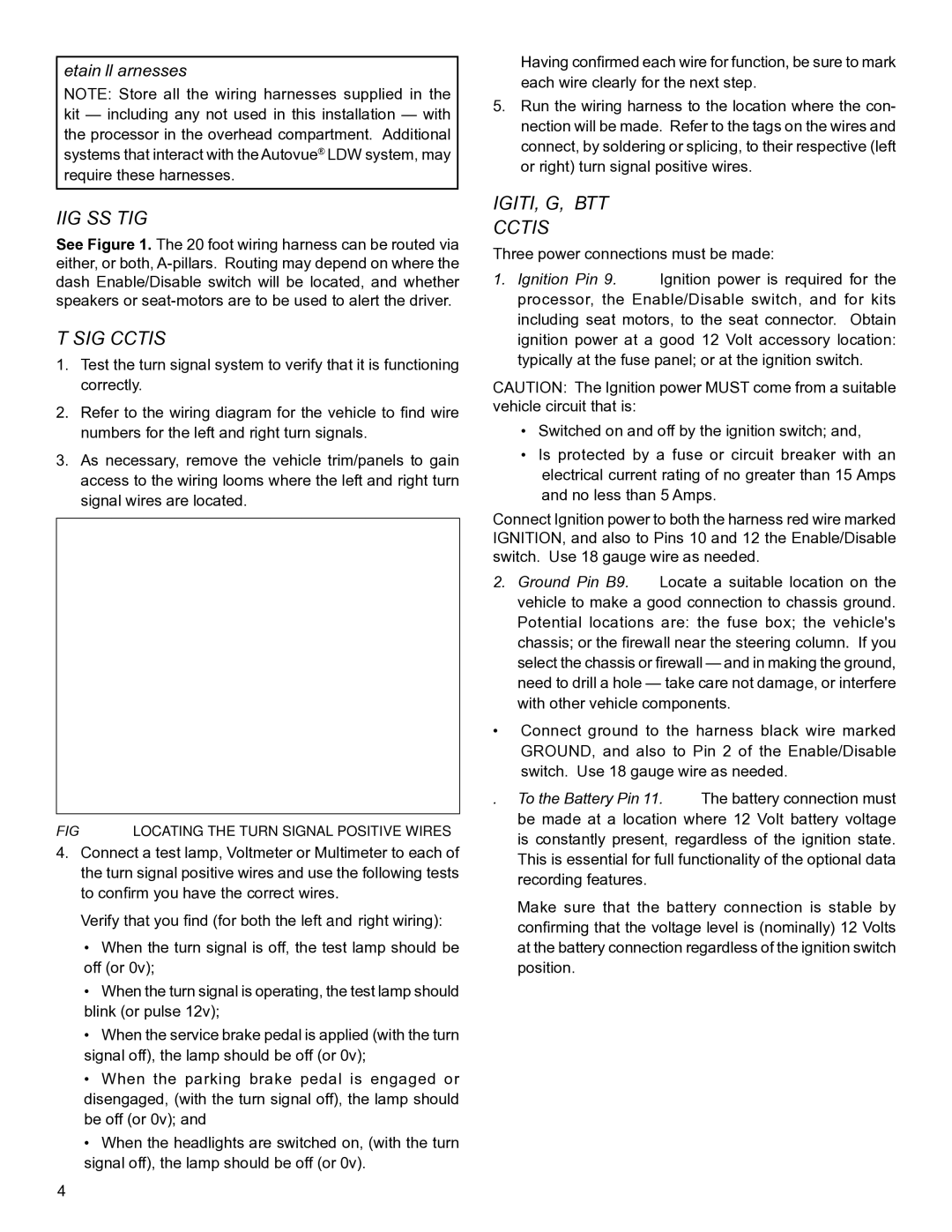
Retain All Harnesses
NOTE: Store all the wiring harnesses supplied in the kit — including any not used in this installation — with the processor in the overhead compartment. Additional systems that interact with the Autovue® LDW system, may require these harnesses.
WIRING HARNESS ROUTING
See Figure 1. The 20 foot wiring harness can be routed via either, or both,
TURN SIGNAL CONNECTIONS
1.Test the turn signal system to verify that it is functioning correctly.
2.Refer to the wiring diagram for the vehicle to find wire numbers for the left and right turn signals.
3.As necessary, remove the vehicle trim/panels to gain access to the wiring looms where the left and right turn signal wires are located.
FIGURE 3 - LOCATING THE TURN SIGNAL POSITIVE WIRES
4.Connect a test lamp, Voltmeter or Multimeter to each of the turn signal positive wires and use the following tests to confirm you have the correct wires.
Verify that you find (for both the left and right wiring):
•When the turn signal is off, the test lamp should be off (or 0v);
•When the turn signal is operating, the test lamp should blink (or pulse 12v);
•When the service brake pedal is applied (with the turn signal off), the lamp should be off (or 0v);
•When the parking brake pedal is engaged or disengaged, (with the turn signal off), the lamp should be off (or 0v); and
•When the headlights are switched on, (with the turn signal off), the lamp should be off (or 0v).
Having confirmed each wire for function, be sure to mark each wire clearly for the next step.
5.Run the wiring harness to the location where the con- nection will be made. Refer to the tags on the wires and connect, by soldering or splicing, to their respective (left or right) turn signal positive wires.
IGNITION, GROUND, AND BATTERY CONNECTIONS
Three power connections must be made:
1.Ignition (Pin A9). Ignition power is required for the processor, the Enable/Disable switch, and for kits including seat motors, to the seat connector. Obtain ignition power at a good 12 Volt accessory location: typically at the fuse panel; or at the ignition switch.
CAUTION: The Ignition power MUST come from a suitable vehicle circuit that is:
•Switched on and off by the ignition switch; and,
•Is protected by a fuse or circuit breaker with an electrical current rating of no greater than 15 Amps and no less than 5 Amps.
Connect Ignition power to both the harness red wire marked IGNITION, and also to Pins 10 and 12 the Enable/Disable switch. Use 18 gauge wire as needed.
2.Ground (Pin B9). Locate a suitable location on the vehicle to make a good connection to chassis ground. Potential locations are: the fuse box; the vehicle's chassis; or the firewall near the steering column. If you select the chassis or firewall — and in making the ground, need to drill a hole — take care not damage, or interfere with other vehicle components.
•Connect ground to the harness black wire marked GROUND, and also to Pin 2 of the Enable/Disable switch. Use 18 gauge wire as needed.
3.To the Battery (Pin A11). The battery connection must be made at a location where 12 Volt battery voltage is constantly present, regardless of the ignition state. This is essential for full functionality of the optional data recording features.
Make sure that the battery connection is stable by confirming that the voltage level is (nominally) 12 Volts at the battery connection regardless of the ignition switch position.
4
